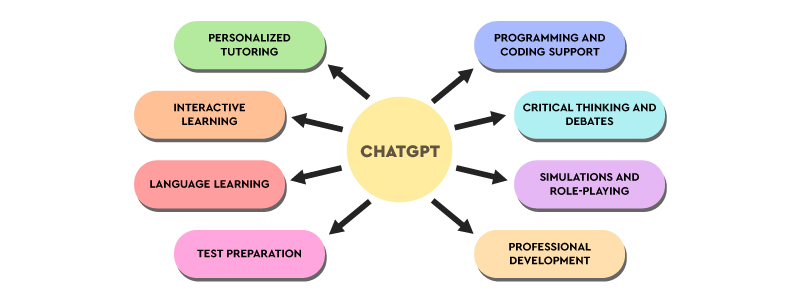ChatGPT, powered by OpenAI's GPT-3.5 architecture, has revolutionized the education sector by providing an interactive and personalized learning experience. ChatGPT can serve as a virtual tutor, guiding and providing feedback to students outside of regular class hours. It can assist with homework, provide practice exercises, or explain complex topics. GPT 4.0 can also assist teachers in locating and creating learning assets that frame and complement their content due to its ability to create video and deliver images. Essentially, teachers can create more effective lessons at a much faster rate. Overall, ChatGPT is a powerful tool that can improve students' learning experiences while also making education more accessible and effective.
Impact of ChatGPT
The impact of ChatGPT in the education sector is transformative, revolutionizing the way students learn and educators teach. Its ability to enhance student engagement, facilitate teacher-student interactions, improve accessibility, and promote lifelong learning makes it a valuable tool in modern education. However, the responsible development and use of ChatGPT are crucial to address ethical concerns and maintain the integrity of the learning process. As AI technology continues to evolve, the education sector should embrace these advancements to unlock the full potential of ChatGPT and create a brighter and more inclusive future for learners worldwide.
ChatGPT can be a valuable tool for education and training in various ways due to its natural language processing capabilities and vast knowledge base. Here are some examples of how ChatGPT can be used for educational purposes:
Personalized Tutoring: ChatGPT can act as a virtual tutor, providing personalized learning experiences for students. It can answer questions, explain concepts, and provide feedback on assignments, tailoring its responses to each student's specific needs and level of understanding.
Interactive Learning: With ChatGPT, students can engage in interactive learning experiences. They can have conversations with the model to explore topics, deepen their understanding, and clarify doubts.
Language Learning: ChatGPT can help learners practice a new language by engaging in conversations, providing translations, and correcting grammar and syntax errors.
Test Preparation: Students can use ChatGPT to prepare for exams by asking questions and receiving explanations for difficult concepts. The model can also generate sample questions and answers to aid in test practice.
Professional Development: ChatGPT can be used for training employees in various industries. It can provide information on new technologies, regulations, and best practices, keeping the workforce up-to-date with the latest developments.
Simulations and Role-Playing: ChatGPT can simulate real-life scenarios, allowing learners to practice decision-making and problem-solving in a risk-free environment.
Critical Thinking and Debates: By engaging in discussions with ChatGPT, students can develop critical thinking skills and practice articulating their ideas and arguments effectively.
Programming and Coding Support: Aspiring programmers can use ChatGPT to seek help with coding problems, understand programming concepts, and get code suggestions.
Writing Assistance: ChatGPT can be used as a writing assistant, helping students improve their writing skills by suggesting improvements, providing grammar and style recommendations, and offering creative ideas.

Mentorship and Career Guidance: ChatGPT can provide guidance to students on career paths, skill development, and educational opportunities, assisting them in making informed decisions about their future.
24/7 Availability: ChatGPT can be accessed at any time, allowing students to learn and seek assistance whenever they need it. This is particularly beneficial for learners with busy schedules or those in different time zones.
Affordability: ChatGPT can offer a cost-effective solution for education and training. It reduces the need for expensive textbooks and additional resources, making knowledge more accessible to those with limited financial resources.
Remote Learning and Distance Education: ChatGPT enables remote learning opportunities, reaching students who may have limited access to traditional educational institutions due to geographical constraints or other reasons.
Non-judgmental Environment: Some students may feel uncomfortable asking questions or seeking clarification from teachers due to fear of judgment. ChatGPT offers a non-judgmental environment for learners to ask questions and explore topics without hesitation.
Despite these benefits, it is important to acknowledge that ChatGPT has limitations and may not fully replace human educators or address all accessibility challenges. Combining the strengths of ChatGPT with human teaching can create a more comprehensive and inclusive educational experience for all learners. Additionally, ensuring that AI technologies are designed and used responsibly and ethically is crucial to avoid exacerbating existing educational disparities.
It is essential to use ChatGPT responsibly and maintain a balance between its use and traditional learning methods. While it can be an effective supplement to education, it should not replace human interaction, feedback, and guidance, which are crucial for holistic learning experiences. Additionally, educators and learners must be aware of potential biases in the AI model's responses and ensure that critical thinking is still encouraged during the learning process. When used wisely, ChatGPT can be a powerful ally in promoting more efficient and personalized education.
About the Author
Dr. B. Karthiga, currently designated as IQAC Co-ordinator at Dhanalakshmi Srinivasan Engineering College (Autonomous), Perambalur. She is an accomplished educator and researcher and boasts a prolific 15-year journey in academia. Her Ph.D. in Information and Communication Engineering from Anna University underpins her expertise in Image Processing, Communication Systems, and VLSI.